 Are you wondering what 2015 might look like for social media marketing?
Are you wondering what 2015 might look like for social media marketing?
If the changes in 2014 are an indicator, there will be a lot more changes in 2015.
To get a grip on what the near future may look like, we tapped the knowledge of 28 social media pros.
Here's what they had to say.
And if you're curious, here were the 2014 predictions.
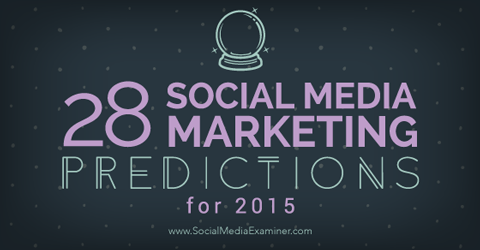
#1: Video Becomes the Content of Choice

In 2015, video will dominate as the social media content format of choice. Further, regular video segments, like podcasts and blog posts, will come into their own as a form of content that drives social engagement and other marketing goals.
Let's look closer. In August 2014, Facebook surpassed YouTube in the number of video views via desktop according to comScore. It's important to note that YouTube still has more views across all devices. As of September 2014, Facebook attracted a billion video views per day, a roughly 30-fold increase since July.
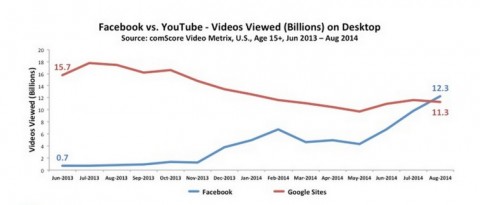
Based on SocialBakers' data, video posting moved away from YouTube towards Facebook in 2014. While these results still show YouTube ahead, the trend favors Facebook.
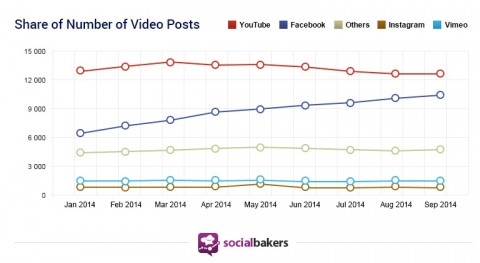
Also, Facebook videos receive significantly more shares than YouTube. This makes sense because sharing and engagement are at the heart of Facebook interactions.
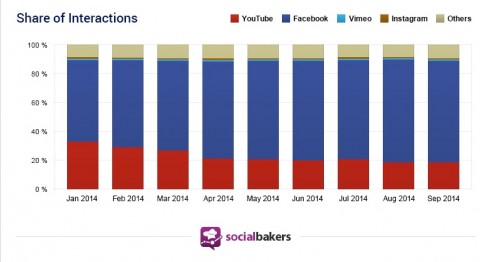
YouTube is the best-performing social media platform to drive trackable sales, according to AOL's Convertro research. It's the first, last or only platform touched.
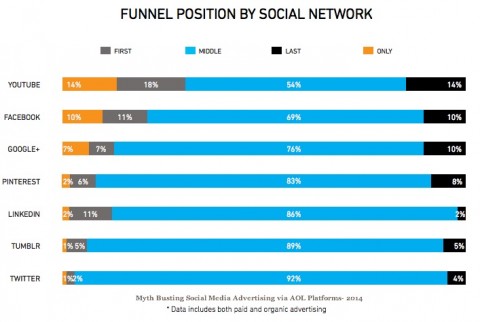
Earlier in 2014, Convince and Convert's Jay Baer introduced his Jay Today, a 3-minute video. Baer cross-promotes and posts this content.
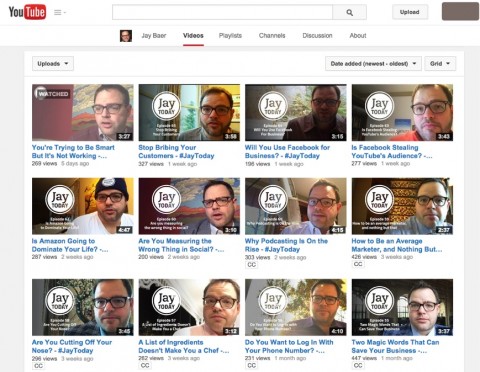
Here's how nimble marketers can jump on this 2015 video trend:
Create your own regular video episodes. Take a page from Jay Baer's playbook. His cost is under $125 per episode!
Get World-Class Marketing Training — All Year Long!
Are you facing doubt, uncertainty, or overwhelm? The Social Media Marketing Society can help.
Each month, you’ll receive training from trusted marketing experts, covering everything from AI to organic social marketing. When you join, you’ll also get immediate access to:
- A library of 100+ marketing trainings
- A community of like-minded marketers
- Monthly online community meetups
- Relevant news and trends updates
Provide the five key types of content your target audience seeks. Use Marcus Sheridan's “They ask, you answer” approach. Record your employees who know the information, but are challenged to put their words in print.
Get your customers into the act. Videos captured with a smartphone are much easier than writing a review. Make it easy for customers by setting up an area of your establishment to encourage them.
Heidi Cohen, president of Riverside Marketing Strategies.
#2: Information Density Creates Hurdles

To me, there is one mega-trend that is like an enormous hammer forging nearly every idea and innovation in our marketing world today: Fighting through information density.
By 2020, the amount of information on the web is expected to increase by 600% (and some believe that number is low!). The challenge of cutting through the content shock and earning a share of the limited customer attention span is the marketing challenge for the foreseeable future.
This reality is behind important shifts occurring in the next year:
Business migration away from Facebook. The drop in organic reach has been apocalyptic for many businesses. Why? There's too much content on Facebook and the company is forced to ratchet down the reach. We'll have to either spend a lot more money on Hollywood-quality content, a lot more money on advertising or both. This will force some businesses to reconsider Facebook as a viable channel and enable a migration to less noisy venues.
Emergence of new content forms. As the web adapts to and adopts these new realities, it will drive innovations that help businesses stand out. I predict that we'll see some interesting new content forms develop in 2015. A couple of areas ripe for innovation are interactive video and new types of short-form visual content.
Fighting through filters. New apps and filters are emerging to help consumers make better content choices. One example is Zite, which filters content for you as it learns about your preferences. As more people turn to these apps to sort the clutter, the marketer's attention will turn toward the new challenge of getting messages through these new filters.
These are just a few of the many implications of this trend. The conversation on the web will turn from “content” to “ignition”—how do we get our message to cut through and compete?
Mark Schaefer, educator, consultant and author of Social Media Explained: Untangling the World's Most Misunderstood Business Trend.
#3: SlideShare Becomes the YouTube for Business

Instagram is to Facebook as SlideShare is to LinkedIn. In other words, look for SlideShare to emerge as the key social network for business professionals to find and share bite-sized pieces of content while on the go in 2015.
SlideShare is currently where you create, distribute and consume presentations, and it's a great tool for B2B marketers to do content marketing for their target audience. Good presentations drive page views, leads, SEO juice and often long-lasting evergreen content. In 2014, SlideShare added video capabilities for LinkedIn influencers. In 2015, SlideShare will extend video to their entire audience. Watch for SlideShare video to become YouTube for business.
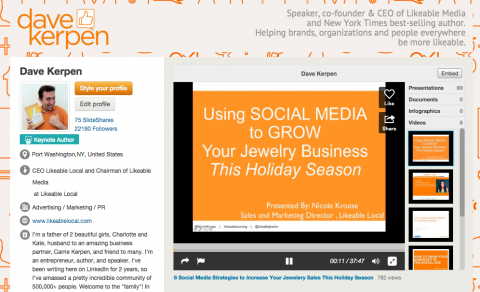
If you're a B2B business or a marketer who represents B2B clients, make sure SlideShare is squarely on your radar for 2015.
Dave Kerpen, CEO of Likeable Local, chairman of Likeable Media and author of Likeable Leadership: A Collection of 65+ Inspirational Stories on Marketing, Your Career, Social Media & More.
#4: YouTube Declines as Social Networks Embrace Hosted Video

Facebook, Twitter and LinkedIn will show preferential treatment to video content that is hosted on their own platform. This means that marketers will be uploading original video content to each social network (and not just short videos).
The social networks will give extra exposure to uploaded videos because they keep users on the platform longer and provide unique advertising opportunities. This distribution of video will radically transform the way marketers work with video.
Michael Stelzner, founder and CEO of Social Media Examiner and author of Launch: How to Quickly Propel Your Business Beyond the Competition and Writing White Papers: How to Capture Readers and Keep Them Engaged.
#5: Social Conversions Become Easier

Social micro-conversions will become an active and successful strategy with every business in 2015.
Currently, businesses look to promote on social media, direct traffic back to their site, introduce a call to action and then drive the visitor through the conversion. The needed behavior is rife with trouble, because it requires the consumer or prospective business to take many steps.
I believe we're going to see a lot more methods across social media that provide direct action through engagement. It may be a purchase through a tweet, mobile click to call, a Facebook registration or a Pinterest purchase, which bypasses the funnel and drives the social user directly to a conversion.

Some of the technologies will be integrated directly into the platforms, but others will be available through third-party applications. Either way, the ability to convert will be drawn closer to the audience and the activity.
This is a fantastic evolution in social media, because of the apparent lackluster conversion performance that companies are seeing when attributing conversions directly to social media activity. I believe its impact is vastly underestimated by businesses right now. By minimizing the steps and complexity, the conversion can be accomplished much easier. As a result, we'll see a growing improvement in social media conversion performance and attribution.
Douglas Karr, CEO of DK New Media and founder of the Marketing Technology Blog.
#6: Paid Ads Become Unavoidable

In 2015, social networks will continue to find ways to push businesses into their advertising programs.
We already know that Facebook plans to stifle organic promotional posts in the news feed starting in January 2015, and that Twitter hasn't ruled out implementing a Facebook-like algorithm for their news feed. Instagram is still busy expanding their advertising platform, and since they're owned by Facebook, an algorithm that limits organic posts from businesses and brands could easily be added into the mix.
Hence, social media marketers who might have avoided social advertising in 2014 will be forced to embrace it in 2015.
Kristi Hines, freelance writer and professional blogger.
#7: Local Search Expands Google+

The rise of Google+, through Google Local Search results, will be a phenomenon in 2015.
Google has created the infrastructure to enable businesses to easily appear in Google search, and so many businesses still haven't claimed their listings.
Once they have five reviews, the stars will be shown. The ‘star game' will start to play out in 2015: authentic reviews will rise to the top and small businesses will have the chance to shine.
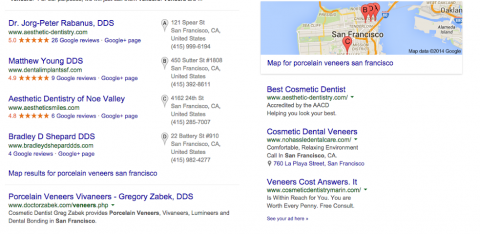
Even though stars are generally not considered to be a main ranking factor, we may all be surprised by their importance in search. By coincidence, above, the listing with the most stars is showing first in the local listings box. Yet generally, stars are considered as social proof, which in turn allows people to feel trust in their decision to click. More stars, more trust.
Combining this with the ability to access good-quality local data through tools such as Spheres (will be live by the end of December 2014), many offline businesses will be taking their first steps into social media.
Once this happens, further social media services can then be supported, including content sharing across multiple platforms.
Google is not in a hurry to bring business into their ecosystem, but this time next year will see a push where it gains even more ground and connections back into the real world.
Martin Shervington, author of The Art and Science of Google+: A psychological, user friendly and sometimes even humorous guide to this new social layer and a marketing consultant.
#8: Tech Innovations Change Marketing

I don't think we'll recognize the future of social media! It's hard to know what will have a greater influence on social media in the future—hardware design or software innovation?
With hardware innovation like Oculus Rift and D-Wave’s Quantum Computer popping up seemingly overnight, there's no telling how hardware will affect the way we interact on social. And it most certainly will affect it, making engagement more intuitive, more in-time and more realistic than ever. Imagine what fully experiential quantum data integration will do to social interaction. The most active post on my Facebook page right now is a raging debate over having chips implanted like they're doing in Sweden.
And then you have folks like Dr. Mark Sagar who recently introduced the first fully responsive, CGI, artificial intelligence baby.
I was sitting in the audience as his baby evoked very real emotional response in myself and in those around me. The future is here and the hashtag is #CrazyCreepyCoolTech!
What hopefully will remain the same, as the future of social spirals into the stratosphere, is the necessity and continuation of true engagement and connection. Whether these technologies will make them easier or more difficult, and whether people will rebel or adopt, remains to be seen.
Viveka von Rosen, a LinkedIn expert, speaker and trainer and the author of LinkedIn Marketing: An Hour a Day.
#9: Silos Break Down

In 2014, there was still a massive disconnect between brands and consumers due to a misuse of social media as a communication tool at the brand level and a misunderstanding of who the customer actually is.
This will be the year brands wake up to the reality that social media is a relationship-builder and not a one-way bullhorn. They will embrace the conversation, knowing that in order to establish meaningful connections, they must break down the social media silo they have created.
Brands will also recognize that the continued humanization of the brand is essential. As digital marketers, we talked about this at length in 2014. However, I continue to see brands speaking at consumers rather than with them. The mental shift to “tell a story,” not simply push a message, will happen.
Look to brands like Charmin, Oreo and Barkbox as prime examples of social media done right. Each one has created a fun, entertaining and interactive brand persona. They understand their audience and work to deliver content that is targeted and consistent in message, voice and branding.

But brands won't make this shift on their own. To succeed, they must align themselves with the correct individual who can transform their vision and mission into a vibrant online personality. Gone are the days of knowing “a little something” about social media and claiming expertise.
In 2015, brands will ask potential social media marketers: Can you create a voice and inspire customers to take action or do you simply publish pre-created content? Do you have a deep understanding into integrated strategy and can you lead a team efficiently and effectively? That distinction will become glaringly evident as brands seek top talent to put a face on the brand.
While most brands will not transform overnight, there'll be a significant push and willingness to embrace risk in order to get there.
Rebekah Radice, founding partner of Imagine WOW.
#10: Campaign Focus Shifts to Experience

In the information-driven and consumer-empowered world, relationship capital is the only business metric that stands the test of time. Brand love and customer advocacy is what takes care of the business bottom-line. To truly earn the trust and loyalty of educated, tech- and social-savvy, global, connected millennial consumers, it isn't enough to distract them with short-term dazzle campaigns. To ignite and keep customer advocacy long-term, companies need to show that they care by repeatedly enabling meaningful experiences.
But to do so, they need a full 360-degree view of their customer, located centrally and accessible to any department within the company. That way—no matter where the customer comes from, who (s)he reaches out to and what the issue is—the company can enable the best experience possible at every touchpoint. Businesses also need to employ people who not only possess the right skillset, but also the right mentality; people who are passionate about serving their customers. And last but not least, they need to have integrated technology that can support the cohesive company-wide strategy.
It will take time and effort to accomplish. Executives will need to work on breaking the internal silos (not the easiest task), bringing the right people and technologies on board and establishing the integrated processes internally. But in the fast-changing digital era, where just having a great product isn't enough anymore to gain a competitive edge, relationship-building and experience enablement is the only answer to not only business survival, but long-term prosperity.
Ekaterina Walter, Global Evangelist at Sprinklr and a bestselling author of Think Like Zuck: The Five Business Secrets of Facebook's Improbably Brilliant CEO Mark Zuckerberg and The Power of Visual Storytelling: How to Use Visuals, Videos, and Social Media to Market Your Brand.
#11: Paid Media Becomes Necessary

In 2014, we witnessed several changes in the way businesses are forced to approach Facebook marketing—first with the drop in organic reach, then the death of the like-gate and now the announcement of how Facebook plans to reduce the amount of promotional content coming from brands in the news feed. We should not be surprised if other networks eventually follow the same path.
In 2015, we'll see the rise of paid media. Small businesses will have to get more educated about how to accelerate the distribution of different types of content at different stages of the sales funnel if they want to survive.
But we're past the like-collecting days and more businesses are understanding the need for a well-designed structure that delivers different types of content to segmented groups of their audiences at the right moment in the marketing cycle. The best way to control the potential reach and manage the segmentation is through paid media.
There are two key things we learned this year that we need to consider in 2015: you can no longer rely solely on organic reach to make a significant impact, and paid media leads to more conversions than organic media.
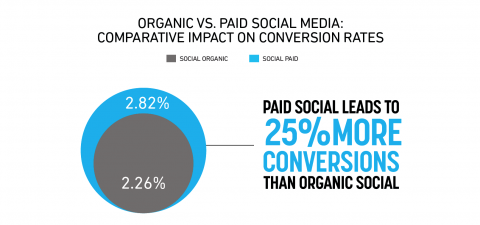
Your focus should be on learning more about the individuals in your audience, as well as understanding how to segment your prospects, whether there is already a connection with your business or not. Plus, establish who needs to see what and when, and determine how you're going to deliver each specific message.
Francisco Rosales, founder of SocialMouths.
#12: Republishing Grows Reach

Facebook spent 2014 tightening the noose on social marketers, and with an algorithm change taking effect in January, shows no signs of stopping in the new year. On top of that, other networks like Twitter continue to grow more crowded, which means getting noticed in a feed or a timeline gets harder and harder all the time. Therefore, reach for individual posts is dropping.
Anyone with a Facebook page can tell you that reach has plummeted, and the reach on any given post is a fraction of what it would have been a year or two ago. That's why in 2015, marketers will focus on getting cumulative reach by republishing their updates multiple times. Instead of posting an update once and hoping for the best, they'll post an update again and again. Instead of trying to take out one large slice of pie, they'll take multiple smaller pieces that add up.
Republishing updates like this may improve reach in more ways than one, because it can afford marketers more time for one-on-one engagement. By spending less time writing unique updates that may or may not hit their targets, marketers will be able to dedicate more time to interacting live with their fans and followers, encouraging the type of engagement that Facebook values and rewards with more consistent organic reach.
Laura Roeder, founder of Edgar and the site, LKR Social Media.
#13: Campaigns Become Platform-Agnostic

We're going to see marketers shift their focus back to “platform-agnostic marketing.” Savvy marketers are realizing that the social space is becoming increasingly fragmented, and creating unique campaigns for each channel is difficult and expensive. For the last few years, you could create a campaign just for Facebook and get good results. But now your audience is everywhere—Twitter, Facebook, Instagram, YouTube and others—each with different reach and engagement.
Along with increased fragmentation, marketers are seeing increased costs to just to have their messages seen. There isn't a free ride anymore. To get the most from your marketing dollars, you'll have to be in more places at the same time.
The best bet is to have one clear goal (increased engagement, sales, data collection, etc.), and then be “everywhere.” In 2015, marketers will create centralized platform-agnostic campaigns that achieve these goals, regardless of where the audience comes from.
Jim Belosic, CEO of ShortStack.
#14: Fans Demand Personal Interaction

Next year will see increased demand for personal interaction with fans and followers. This means that fans today want to get to know the people behind the logo or brand and want to see who it is they're engaging with.

Discover Proven Marketing Strategies and Tips
Want to go even deeper with your marketing? Check out the Social Media Marketing Podcast! Publishing weekly since 2012, the Social Media Marketing Podcast helps you navigate the constantly changing marketing jungle, with expert interviews from marketing pros.
But don’t let the name fool you. This show is about a lot more than just social media marketing. With over 600 episodes and millions of downloads each year, this show has been a trusted source for marketers for well over a decade.
Companies that have already grasped this concept are not only seeing a lot more interaction on their content, but also building up a higher level of trust. This approach lets their fans know there's a real person behind the company who cares about what they have to say and is there to respond.
A great example of this is demonstrated by Gary Vaynerchuk, who started up a new online video series called the Ask Gary Vee Show.
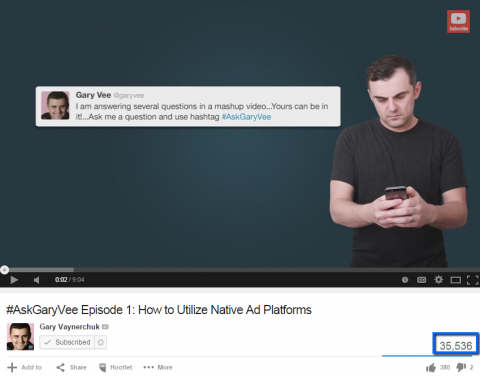
The aim of the show is to highlight current topics in the world of social media and answer questions submitted by fans through the hashtag #AskGaryVee. Where the show separates itself from others out there is that Gary presents the whole show face to face, with the camera giving his followers that personal interaction as he reads out loud and answers user-submitted questions.
This is a great way for Gary to consistently engage his fans, since they can submit questions through using the hashtag and then tune in to see if their question got answered. The key to building these stronger relationships in 2015 is going to come from personal-style content. More importantly, companies will need to respond to their communities in a timely manner.
Ravi Shukle, Facebook marketing specialist and the host of the new podcast, Crown Your Community.
#15: Social Media Goes Niche

In 2015, I foresee the rise of a smaller, more personal social media trend that focuses on niche groups and specific, shared qualities or interests.
We've always shared with specific people or to small groups through “dark” channels like email or text messaging right alongside our broader social media sharing. In the coming year, I predict that this type of sharing will begin to get more notice from marketers and app developers.
The emergence of new, more focused social media networks like Ello and This—even Facebook's experimental Rooms—as well as the explosive growth of apps like Snapchat that allow users to target a specific social media audience, indicate that this groundswell may have already begun.
Combine this with the increasing challenge of getting noticed in Facebook's crowded news feed and the announcement that a Twitter algorithm is likely on the way soon, and the stage is set for some big changes in the way we communicate socially.
For brands, this change could mean exploring new and diverse social media spaces on an authentic human scale, as you find your community wherever they might gather.
Courtney Seiter, content crafter at Buffer.
#16: All Social Networks Offer Paid Visibility

The majority of the social networks will copy Facebook's model for displaying information to their users. That means other social networks will begin filtering what posts your friends or followers see.
Why? Because there is a lot of noise on these social sites, which causes users to decrease their engagement. Sure, as a user, you can unfollow or unfriend certain people. However, if the majority of their posts are great, you still want to see what they have to say. You just don't want to see the junk.
In addition to improving user experience, this model can help these social sites generate extra income. For example, any additional revenue that publicly traded companies can squeeze from their users means higher stock prices.
Although most people or companies won't pay to guarantee all of their posts are seen by others, larger companies will. Paying for the visibility of their content will ensure they are getting traffic and the brand exposure they're looking for.
If you want all of your content to be seen without having to spend any money, share high-quality content or updates on a regular basis. Also make sure the majority of your followers are interacting with your content. For example, if you don't know half of your friends on Facebook, you can't expect them to be as engaged as your real friends would be. For this reason, you may be better off unfriending those users. Having interested followers will produce higher engagement rates, which will prompt the social network to show your content to more people.
Neil Patel, co-founder of Crazy Egg and KISSmetrics.
#17: Marketing Requires a Combination Approach

No longer will there be social media marketers who focus on only one network. They will be extinct!
Integrated social media marketing will become a “must” for implementation. For too long marketers have been doing “Facebook marketing” and “Twitter marketing” plus other marketing in isolated silos. As we've seen in 2014 with Facebook reach, if a business focuses on only one social platform, changes to that platform can be disastrous. Therefore, the importance of integrated marketing will headline 2015.
Smart marketers will need to use a combination approach. They'll need to focus on multiple social networks and the ways to use them in power combinations. For example, sharing on Twitter a video or image your brand posted to Facebook can add value to the Facebook post. Marketers will have to find ways to weave together and drive social traffic from one network to another.
Brands need to think cohesively about their “online social marketing plan” that uses their website as the foundation for great content and then integrates cross–social platform sharing to enhance reach and boost engagement from one platform to another.
Below is a great example from Peg Fitzpatrick. She starts with a great blog post on her website, which is then socially shared.
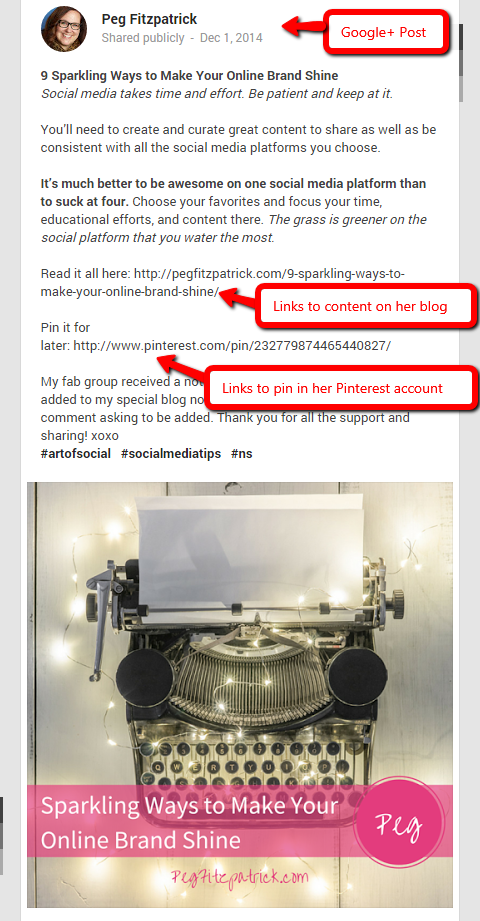
In this example, Peg shares to Google+ and refers back to the post on her website. It also incorporates a “Pin it for later” convenience option that when clicked allows the user to pin the image to his or her own board on Pinterest. So it includes multiple social networks for sharing, all of which drive back to her website where she has email opt-in forms to grow her email list.
This is the integrated, synergistic online marketing approach that marketers will need to implement in 2015.
Mike Gingerich, co-founder of TabSite.
#18: Visual Content Ups Its Game

Visuals, visuals, visuals! This will be the year we see marketers take images and videos to the next level. Over the past couple of years we've seen visual platforms like Pinterest and Instagram skyrocket in popularity. Plus, more recently, videos have become more popular on Facebook.
We've also seen tools come on the scene that make creating awesome visuals super-easy and fun to do. Canva has made image creation a breeze and mobile apps such as PicStitch and Wordswag put the power of creating interesting images and videos for Instagram right in our pockets.
No longer are great images limited to businesses with huge budgets for professional photographers and graphic designers. Now, businesses with the smallest budgets can create images for their content. This is a good thing because consumers will expect higher-quality images. In the early days of Pinterest and on Instagram almost anything could get attention with repins or likes. Now there's so much competition on these platforms, not just any image will do.
Great visuals also go a long way in helping people establish trust with your online presence. Have you ever been to a doctor's office with outdated furniture and old magazines in the racks? Unless you've been seeing that doctor for a long time, you might question his or her professionalism. Not using images in your content or using bad outdated ones can reflect negatively on your business. People could think of your business as less professional or less reputable.
On the flipside, when it comes to videos, I predict that we'll see them become less produced and more relaxed and natural. There'll no longer be a need to set up a studio with a production crew for every video you create. Social media audiences will find the spur-of-the-moment videos created on a smartphone more relatable and engaging.
Cynthia Sanchez, writer and podcast host at Oh So Pinteresting.
#19: Marketers Take Control of Content

We are tribal by nature. As such, I believe there'll be a continual move toward common-interest communities that fuel our innate need to tell stories and communicate as a group. This includes Facebook groups, LinkedIn groups, group boards on Pinterest and Google+ communities. Hashtags will also continue to shine on Instagram and Twitter as a way to stake our claim to a topic or niche and build community by curating content around that topic.
When you establish a group on any of these platforms, both the founders/admins and the people who join the group actually want to find each other. They are looking for conversations about mutual interests. They want to see your content in a place where they're not distracted by main news feeds.
It's not surprising that many businesses are reporting the benefits of establishing a Facebook group separate from their Facebook page. As pay-to-play becomes more of a necessity for having your content seen on Facebook, the popularity of groups brings a degree of control over what content we share and how we communicate with each other.
In my experience, the best communities are those that focus on sharing content and helping each other instead of being about promotion. If you build trust as someone who brings people together and guides them to share and support each other, you'll build relationships with the people who matter most to your business, without giving “reach” a second thought.
Donna Moritz, founder of Socially Sorted.
#20: Hashtags Build Collaborative Communities

This will be the year of the collaborative community. On- and offline there is an opportunity to build relationships and expand our sphere of influence from communities outside our own. We should become more relaxed about sharing what we do and who we know. I call it “lead with giving.” In this evolution of how to do business, everyone wins.
The hashtag is the anchor of the social media revolution. A single hashtag connects a conversation across Instagram, Pinterest, Twitter, Facebook and Google+. From these conversations, a community can quickly be formed; people with common interests are united. These conversations are also the place where businesses conduct their most powerful market research.
Today, even when you can't physically be at an event, you can still join the conversation, thanks to the hashtag. Be a part of the conversation before, during and after the event to get the total experience!
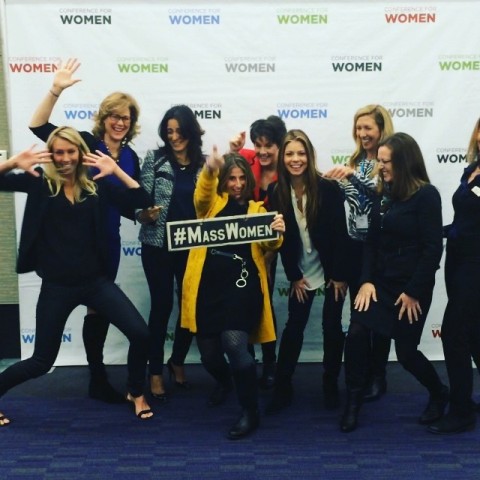
Build your community through your expertise and your experiences. This mindset will help transform how we receive information and how we communicate our knowledge. Make 2015 #InstaAmazing.
Sue B. Zimmerman, founder of Insta-Results™ and author of Instagram Basics for Your Business.
#21: Paid Media Becomes the Norm

Paid media isn't going away. In fact, budgeting for paid media will be more important than ever, as it will be more integrated with earned and owned media.
This year, we saw social media platforms like Pinterest and Instagram introduce ads to a number of businesses as they strove towards monetization. Next year, we can definitely expect them to make a worldwide rollout.
The use of social media will only continue to rise as the number of people who join these social media channels climbs. We can expect organic reach to continue to decline as the volume of content on these networks increases.
To make up for the decrease in organic reach and to get content across, businesses will need to pay to play or watch their content wash away. Soon the idea of free attention will vanish and paid media will be the norm.
I believe this is a natural progression, since there are only a number of things we can see at any single time.
The increasing competition to get content across will in turn evolve paid media into another level, as businesses try to satisfy consumers' thirst for good content. Native advertising and sponsored posts garnered a lot attention from businesses this year. We can expect better integration and coherence with its platforms moving forward.
While most people might find this disturbing, I think if paid media continues to evolve, we might just get good actual content.
Aaron Lee, social media manager, entrepreneur and the grandmaster of customer delight at Post Planner.
#22: Visual Marketing Explodes on SlideShare

The recent upgrades to SlideShare put it in place to be the hottest social platform in 2015. LinkedIn owns SlideShare.
LinkedIn started delivering solid traffic to blogs in 2014, as well as on-platform publishing. SlideShare will seal the deal as a viable social platform, proving that LinkedIn is no longer just for finding a job.
SlideShare offers an easy way to create an enhanced version of a blog post or repurpose a presentation. Building your visual brand across the web has proven to be a powerful piece of the branding puzzle. A great SlideShare can help showcase your expertise and build thought leadership.
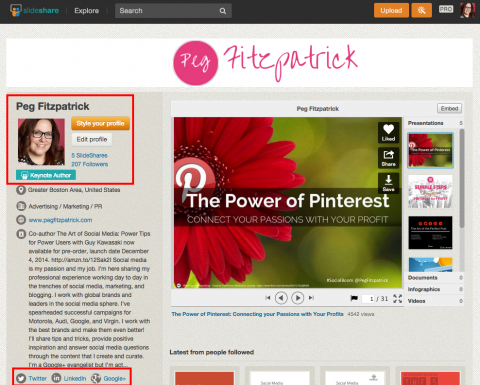
Solid features of the upgraded SlideShare:
- Upload infographics to SlideShare
- Download leads from views of your SlideShares
- Keynote author status for select accounts, offering special features and wider exposure
- Customizable profile page
- Clickable links at the end of the presentation, which direct traffic to your website
- Integration with Haiku Deck, so you can create a presentation directly in SlideShare
- Analytics
A fun way to showcase a SlideShare is to make a GIF of your presentation using GIF Deck. Embedding a SlideShare into your blog post or post published on LinkedIn is a snap with the provided embed codes. You can also add them into your next email blast. And they look great on mobile!
With its versatility, link-building opportunities and lead gathering, it's hard to deny SlideShare's value to your content marketing bottom line. Add SlideShare to your content marketing plan and see how it can boost your visual marketing in 2015!
Peg Fitzpatrick, co-author of the upcoming book, The Art of Social Media: Power Tips for Power Users and a social media strategist.
#23: Social Marketers Become Selective

Social media is becoming increasingly competitive and complex. If it was possible to be a social media expert three years ago, it's definitely impossible today. And it becomes even worse as we enter 2015.
Specialization is unavoidable. No one can be a Facebook expert, Twitter expert, Instagram expert and Pinterest expert all at once. On top of that, the advertising options offered by each of these platforms are becoming so complex that mastering them requires an enormous amount of testing, experimenting and learning.
You can't do it all (let alone do it all well), so you'll have to make choices.
As a consequence, business owners and marketers will have to change the way they approach social media and be much more focused on the things that work for them, while getting rid of the ones that don't. Will 2015 be the year you'll delete your Facebook page, remove your Instagram account or stop your Facebook advertising? Maybe.
In order to do that, measure your results on social media to make sure you invest your time well.
Take a step back. List the social media efforts that paid off back in 2014 and the ones that didn't. Then make some hard decisions, based on what you can measure.
The only way to handle the growing complexity of the social media marketing world is to be selective. And you need the right data to make the right choices.
Emeric Ernoult, founder of AgoraPulse.
#24: Direct Buying Becomes Mainstream

In 2015, both Twitter and Facebook will introduce the Buy button and we'll see significant sales happening through these platforms. I don't imagine that you'll be buying products for a few hundred dollars, but you will hand over micro-payments. For example, it makes perfect sense for authors launching a book to offer it for sale directly on Twitter and Facebook.
We know that Twitter and Facebook are already testing this out. I think that they both will partner with Stripe to do all the payment processing.
LinkedIn will follow with a similar payment system, but I don't see this happening until 2016.
As people get used to handing over smaller amounts of money, Facebook will develop a marketplace for products and services in years to come. Why not go shopping with your friends online?
Ian Cleary, founder of RazorSocial.
#25: Social Media Marketers Rebrand

The popularity of the search term “content marketing” is gradually catching up with “social media marketing,” and service providers will react by broadening their services and repositioning their brands.
This trend started with SEO companies a few years ago when content marketing emerged as the most sustainable (and safest) way to improve search rankings. But as demand for content marketing services grows, social media marketers will be next to jump on the bandwagon.
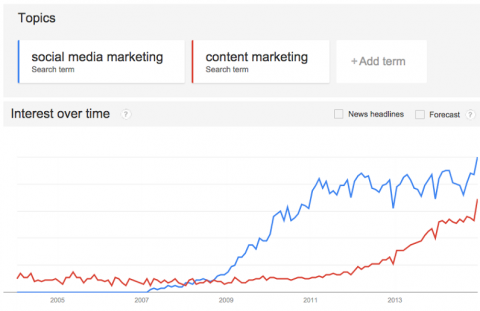
Companies looking for content marketing services will need to look deeper into the history of each service provider to learn the legacy and favorite strategies of each. In other words, the branding of marketing companies will converge, but the “flavors” of the providers won't.
Content marketers with different backgrounds will continue to focus on different channels.
Social media marketing backgrounds drive results through content, connections and micro-targeting through social ads.
-
PR and communications backgrounds drive results through strategic messaging and high-level outreach.
- Search engine marketing backgrounds drive results through technical on-site fixes and tactical outreach.
But in the end, the demand for social media as a specific service will continue to exceed the demand for content marketing services in 2015.
Andy Crestodina, principal and strategic director at Orbit Media and the author of Content Chemistry: An Illustrated Handbook for Content Marketing.
#26: Businesses Embrace Owned Digital Assets

In 2015, I believe there'll be a renewed focus on building and growing owned digital assets such as websites, blogs and communities. Social media has offered tremendous content distribution and engagement opportunities over the past few years, but it's become much more noisy, expensive and difficult to reach your audience. Additionally we don't own our space or our connections on social networks, and the rules are changing constantly.
To reduce these risks, businesses will seek out alternative avenues for content distribution, such as creative partnering, influencer marketing and niche content-sharing platforms to achieve more targeted visibility and engagement. Also, content curation as an “owned” content strategy becomes more prominent and acceptable.
This will be the year of social media awakening as more businesses realize that owned digital assets build greater long-term value with less risk.
Stephanie Sammons, founder and chief strategist at Wired Advisor.
#27: Video Creates Engaging Experiences

As humans, we each define a positive experience differently. When we have experiences that go above and beyond expectation, we want to share them and engage our friends and followers. To benefit from this innate behavior, companies need to think through and create world-class shareable experiences for their audience.
Since videos are likely the easiest ways to share a moment, video marketing will take off in 2015 in ways we've never seen before.
Video gives us the most context around people, companies and things over any other online medium. Start thinking about video as experiential. This is where 3D glasses and video start to give us the ability to play with video and experience stories, shopping and interactions in new ways. (Remember that Facebook bought a 3D company in 2014.)
It seems like loyalty and its definition have changed overnight. Customers who want different things will expect and deserve a personal experience in 2015. So give them unique, engaging experiences. And use video and creativity to do it.
Bryan Kramer, CEO of PureMatter, host of the From the Author's Point of View podcast and author of There is No B2B or B2C: It's Human to Human: #H2H.
#28: More Apps Support Anonymity

The web has gone back and forth on anonymity. In the early days, everything you did online was anonymous. But that eventually moved to you having to use your real name because of hate messages, bullying and even crimes. If you weren't going to say what you had to say using your real name, the web decided you probably shouldn't be saying it at all.
In 2014, anonymous social media apps such as Whisper, Secret, YikYak and Facebook Rooms emerged and gained popularity fairly quickly. Once again, we can air our grievances with little risk of real-life consequences.
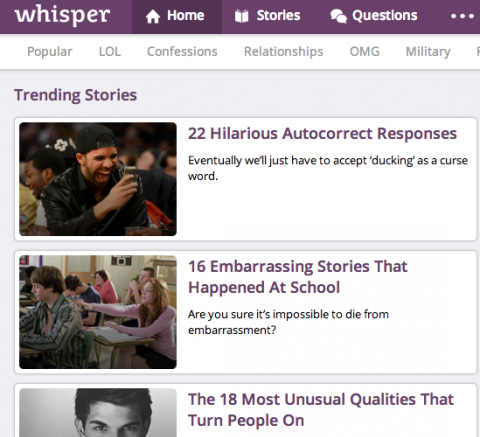
There are two big reasons for this: We miss our privacy a great deal and communities of commonality are important. We see this with Pinterest and Foodspotting and Instagram.
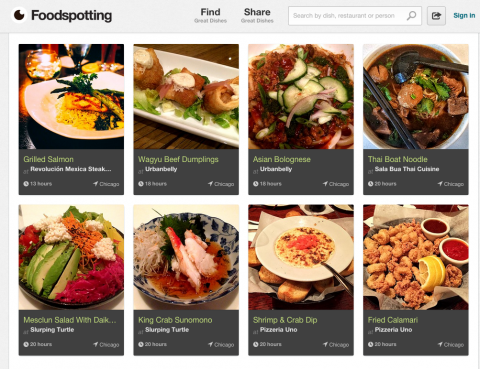
That is why a social media trend in 2015 will be anonymous apps.
We want to go back to the days of yore when we could go to a website, enter anonymously and make friends with like-minded people. We want the serendipity of making new friends around the globe, without necessarily knowing any of their demographic information. We want to be able to say what's on our minds without having the backlash of the social media mob.
Of course, nothing we post online is really anonymous, but these social networks will continue to gain steam, and more will be introduced because we like the veiled privacy of it all.
Gini Dietrich, CEO of Arment Dietrich, Inc.
What do you think? Do you agree with these social media marketing predictions? Do you have any you'd like to share? Please share your comments below.
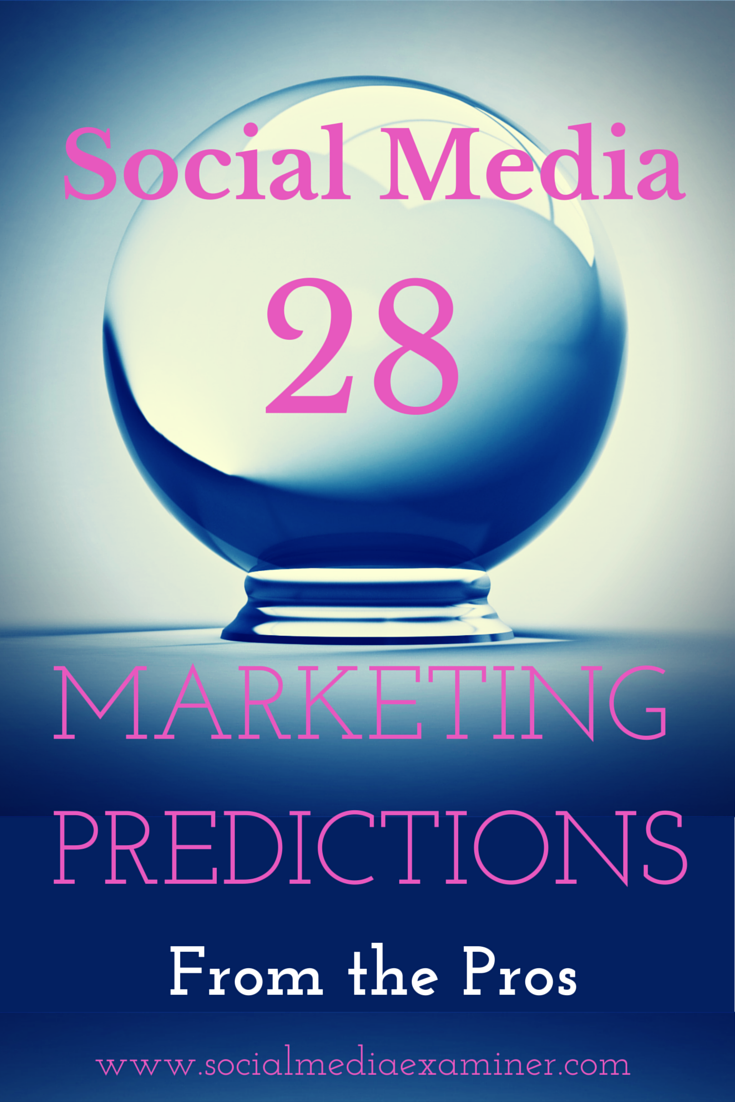
Attention Agency Owners, Brand Marketers, and Consultants

Introducing the Marketing Agency Show–our newest podcast designed to explore the struggles of agency marketers.
Join show host and agency owner, Brooke Sellas, as she interviews agency marketers and digs deep into their biggest challenges. Explore topics like navigating rough economic times, leveraging AI, service diversification, client acquisition, and much more.
Just pull up your favorite podcast app, search for Marketing Agency Show and start listening. Or click the button below for more information.

